Simulations of the EAS Development in the Atmosphere and Detectors for Experiments with the High-Altitude Ionization Calorimeter ADRON-55
Abstract
1. Introduction
2. High-Altitude Ionization Calorimeter ADRON-55
2.1. Installation “ADRON-M”
2.2. Ionization Calorimeter “ADRON-55”
3. Simulation of Vertical EASs from PCR Particles
3.1. Simulation of EASs Initiated by PCR Protons, Medium and Heavy Nuclei
3.2. Simulation of EASs from PCR Strangelets
3.2.1. Some General Results of EASs at E0 = 100 PeV
3.2.2. Results of EAS Simulation in the Shower Axis Region
4. Passage of EAS Particles through ADRON-55
4.1. Basic Information
4.2. Geometry of the “ADRON-55” Calorimeter Model
4.3. Information Saved at the End of the Simulation
4.4. Visual Examples of Simulation Results
4.5. Some Results of Simulation of Events in “ADRON-55”
5. Conclusions
Author Contributions
Funding
Data Availability Statement
Conflicts of Interest
References
- Amineva, T.P.; Glavach, T.G.; Aseikin, V.S.; Vavilov, Y.N. Installation for studying extensive air showers and nuclear interactions of cosmic-radiation particles with an energy of 1012–1016 eV. Trudy FIAN 1970, 46, 157. (In Russian) [Google Scholar]
- Aseikin, V.S.; Bobova, V.P.; Goryacheva, G.Y.; Nikolsky, S.I.; Yakovlev, V.I. Absorption of the energy flux in the cores of extensive air showers. Izv. AN USSR 1974, 38, 998–1002. (In Russian) [Google Scholar]
- Nikolsky, S.I.; Yakovlev, V.I.; Pavljuchenko, V.P. Hadronic Cascades with Anomalous Absorption in the Lead. In Proceedings of the 15th International Cosmic Ray Conference, Plovdiv, Bulgaria, 13–26 August 1977; Volume 8, p. 130. [Google Scholar]
- Nikolskaya, N.M.; Pavlyuchenko, V.P.; Yakovlev, V.I. Parameters of High Energy Cores of EAS Detected with the Big Ionization Calorimeter on Tien Shan Mountain Station; P.N. Lebedev Physical Institute: Moscow, Russia, 1989. (In Russian) [Google Scholar]
- Shaulova, S.B.; Bezshapov, S.P. Looking for Strange Quark Matter in Cosmic Rays. EPJ Web Conf. 2013, 52, 04010. [Google Scholar] [CrossRef]
- Shaulov, S.B.; Beyl, P.F.; Beysembaev, R.U.; Beysembaeva, E.A.; Bezshapov, S.P.; Borisov, A.S.; Cherdyntceva, K.V.; Chernyavsky, M.M.; Chubenko, A.P.; Dalkarov, O.D.; et al. Investigation of EAS cores. EPJ Web Conf. 2017, 145, 17001. [Google Scholar] [CrossRef][Green Version]
- Mukhamedshin, R.; Sadykov, T.; Serikkanov, A.; Argynova, A.; Iskakov, B.; Argynova, K.; Mahmet, H.; Novolodskaya, O.; Idrissova, T.; Zhukov, V.; et al. Studies of Anomalous Phenomena in the Development of Electron-Nuclear Cascades in the EAS Cores Registered by a Modernized Complex Installation at Mountain Altitudes. Appl. Sci. 2023, 13, 2507. [Google Scholar] [CrossRef]
- Heck, D.; Pierog, T. Extensive Air Shower Simulation with CORSIKA: A User’s Guide; Version 7.7410 from 30 April 2021; Institut fur Kernphysik: Heidelberg, Germany, 2021. [Google Scholar]
- Kalmykov, N.N.; Ostapchenko, S.S. The nucleus-nucleus interaction, nuclear fragmentation, and fluctuations of extensive air showers. Phys. At. Nucl. 1993, 56, 346. [Google Scholar]
- Kalmykov, N.N.; Ostapchenko, S.S.; Pavlov, A.I. A model of quark-gluon strings with allowance for jets and EAS. Izv. RAN Ser. Fiz. 1994, 58, 21. [Google Scholar]
- Kalmykov, N.N.; Ostapchenko, S.S.; Pavlov, A.I. EAS and a quark—Gluon string model with jets. Bull. Russ. Acad. Sci. (Phys.) 1994, 58, 1966. [Google Scholar]
- Kalmykov, N.N.; Ostapchenko, S.S.; Pavlov, A.I. Quark-Gluon String Model and EAS Simulation Problems at Ultra-High Energies. Nucl. Phys. B (Proc. Suppl.) 1997, 52, 17. [Google Scholar] [CrossRef]
- Sadykov, T.; Mukhamedshin, R.; Galkin, V.; Argynova, A.; Almenova, A.; Argynova, K.; Makhmet, K.; Novolodskaya, O.; Idrissova, T.; Zhukov, V.; et al. First Results of Studying EAS Cores Using a High-Mountain Ionization Calorimeter. Particles 2024, 7, 40–51. [Google Scholar] [CrossRef]
- Allison, J.; Amako, K.; Apostolakis, J.; Araujo, H.; Dubois, P.A.; Asai, M.; Barrand, G.; Capra, R.; Chauvie, S.; Chytracek, R.; et al. Geant4 developments and applications. IEEE Trans. Nucl. Sci. 2006, 53, 270–278. [Google Scholar] [CrossRef]
- Geant4 Guide for Physics Lists, Release 11.0, Geant4 Collaboration, Rev6.0; Cern: Geneva, Switzerland, 2021; Available online: https://geant4.web.cern.ch/docs/ (accessed on 3 July 2024).
- Apostolakis, J.; Asai, M.; Bogdanov, A.; Burkhardt, H.; Cosmo, G.; Elles, S.; Folger, G.; Grichine, V.; Gumplinger, P.; Heikkinen, A.; et al. Geometry and physics of the Geant4 toolkit for high and medium energy applications. Radiat. Phys. Chem. 2009, 78, 859–873. [Google Scholar] [CrossRef]

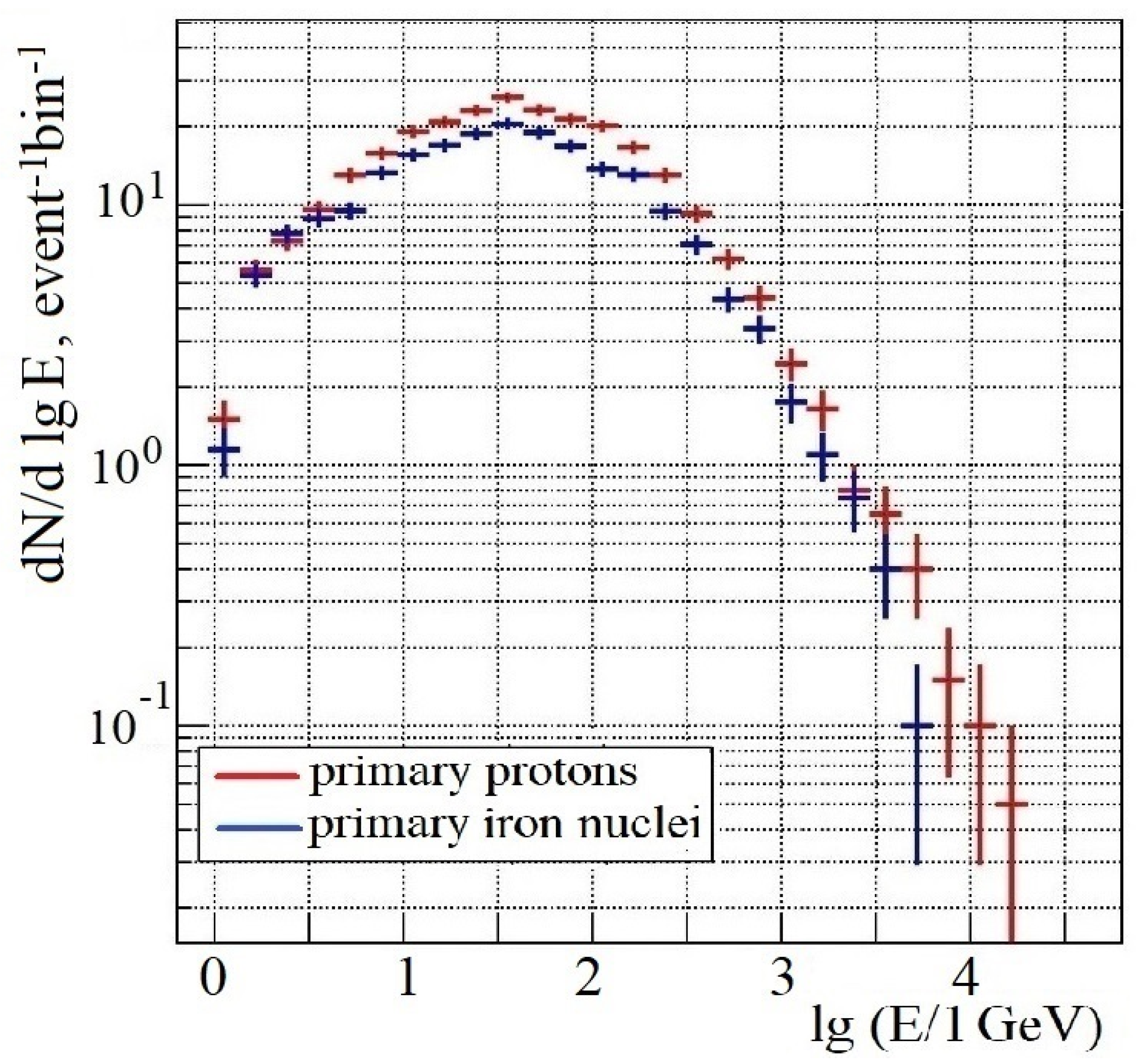


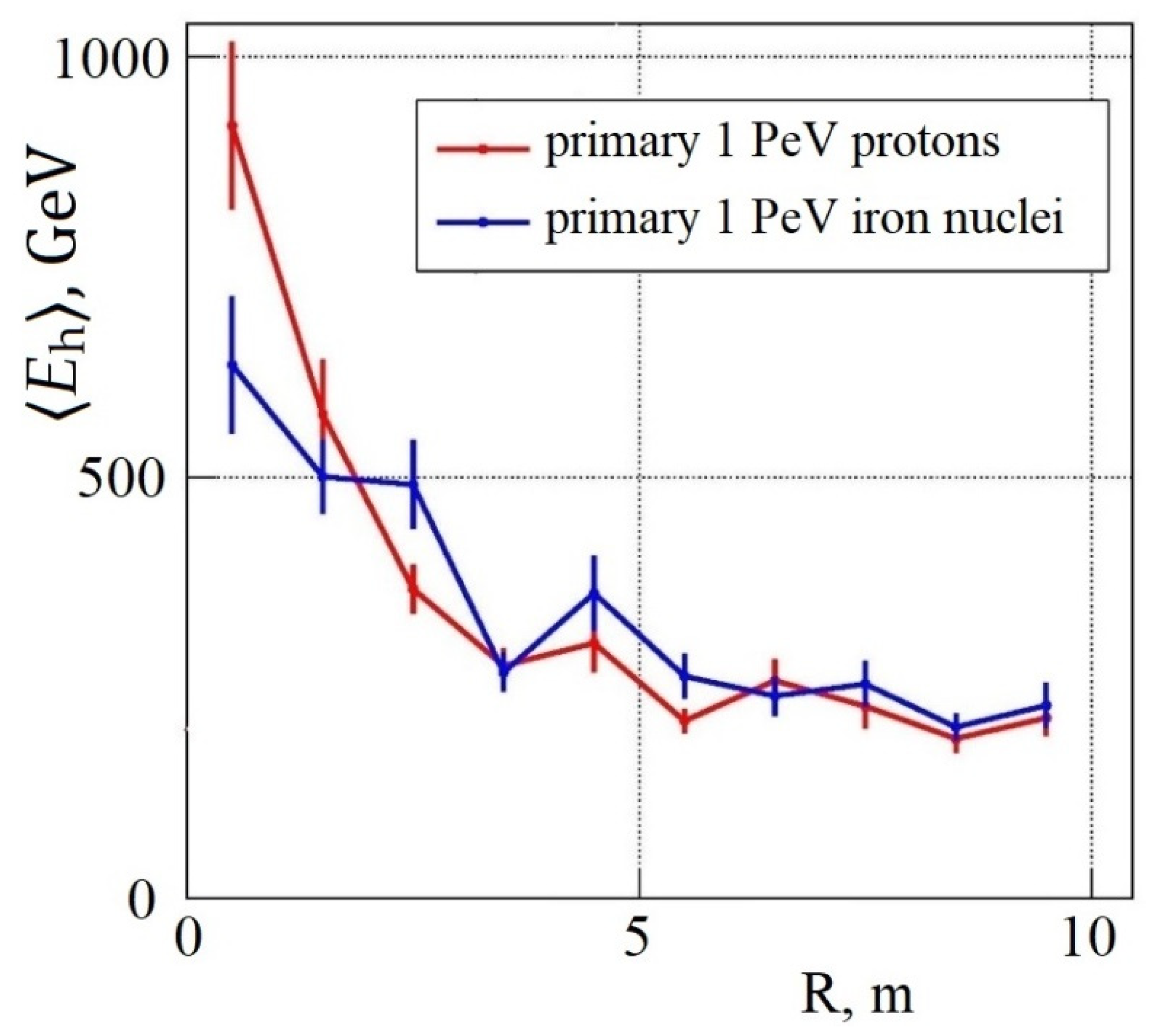

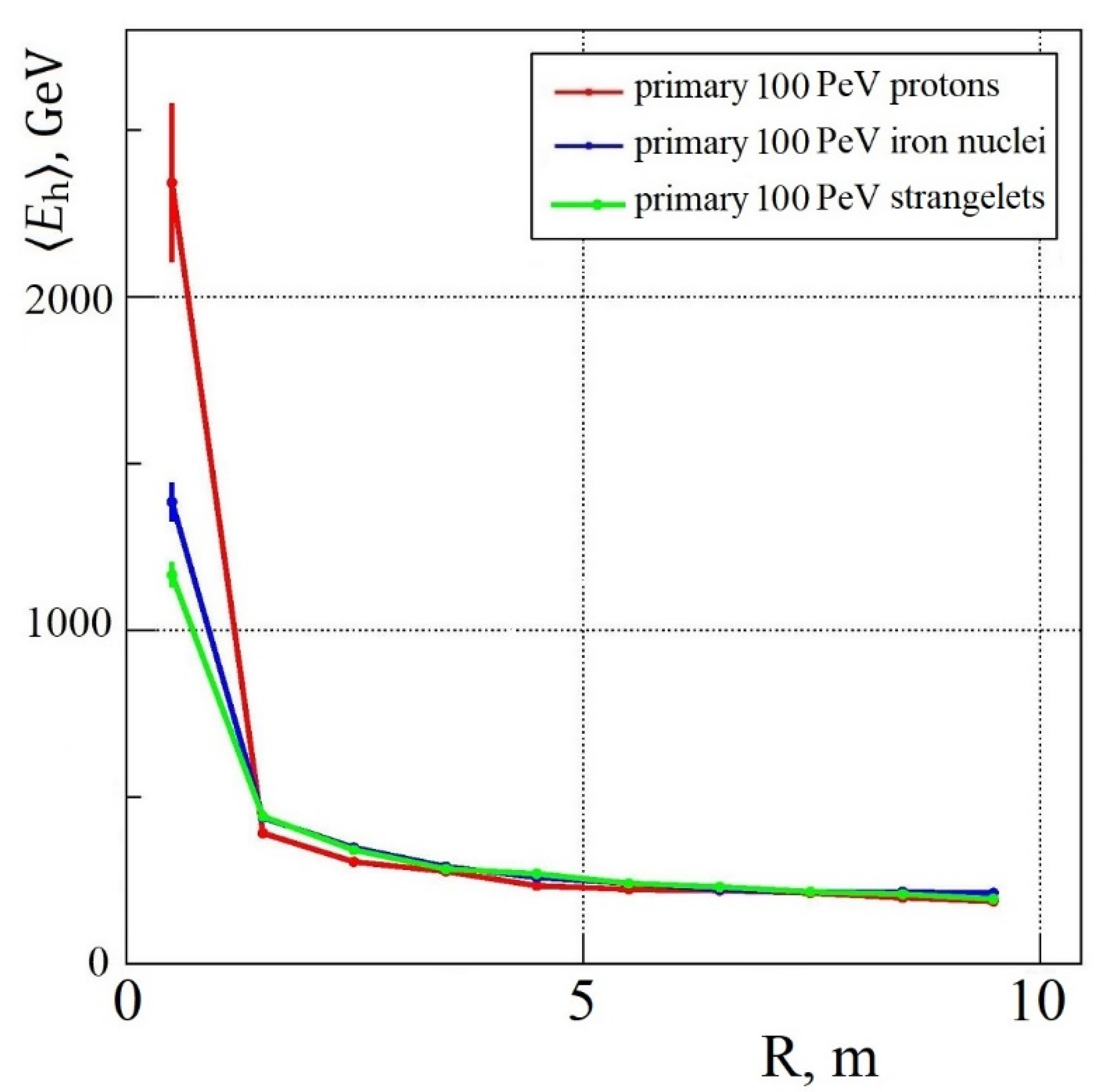
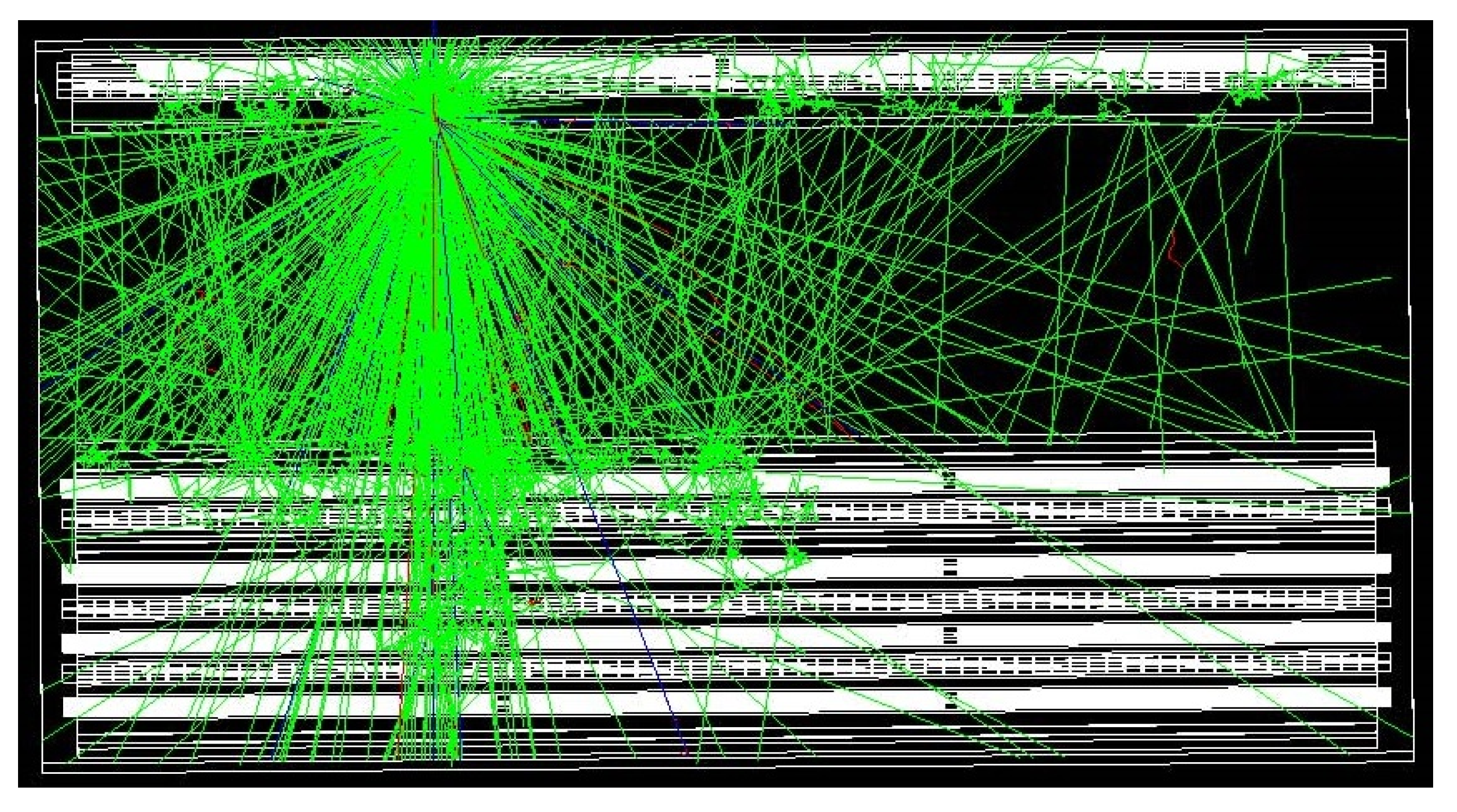


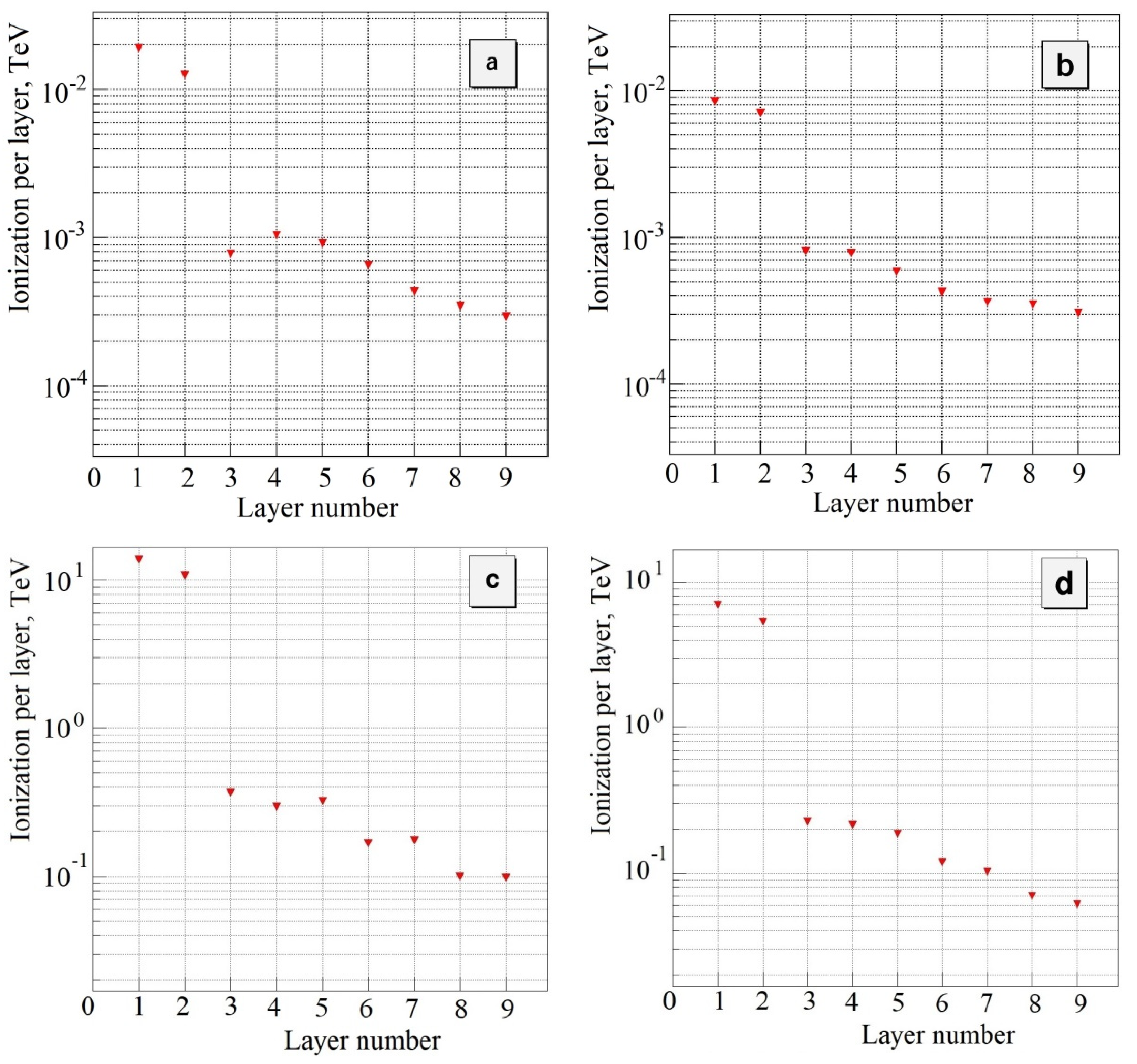

Disclaimer/Publisher’s Note: The statements, opinions and data contained in all publications are solely those of the individual author(s) and contributor(s) and not of MDPI and/or the editor(s). MDPI and/or the editor(s) disclaim responsibility for any injury to people or property resulting from any ideas, methods, instructions or products referred to in the content. |
© 2024 by the authors. Licensee MDPI, Basel, Switzerland. This article is an open access article distributed under the terms and conditions of the Creative Commons Attribution (CC BY) license (https://creativecommons.org/licenses/by/4.0/).
Share and Cite
Sadykov, T.; Yelemessov, O.; Mukhamedshin, R.; Galkin, V.; Argynova, A.; Argynova, K.; Makhmet, K.; Zhukov, V.; Ryabov, V.; Khussainov, Y. Simulations of the EAS Development in the Atmosphere and Detectors for Experiments with the High-Altitude Ionization Calorimeter ADRON-55. Particles 2024, 7, 768-779. https://doi.org/10.3390/particles7030044
Sadykov T, Yelemessov O, Mukhamedshin R, Galkin V, Argynova A, Argynova K, Makhmet K, Zhukov V, Ryabov V, Khussainov Y. Simulations of the EAS Development in the Atmosphere and Detectors for Experiments with the High-Altitude Ionization Calorimeter ADRON-55. Particles. 2024; 7(3):768-779. https://doi.org/10.3390/particles7030044
Chicago/Turabian StyleSadykov, Turlan, Omarkhan Yelemessov, Rauf Mukhamedshin, Vladimir Galkin, Alia Argynova, Korlan Argynova, Khanshaiym Makhmet, Valery Zhukov, Vladimir Ryabov, and Yerkin Khussainov. 2024. "Simulations of the EAS Development in the Atmosphere and Detectors for Experiments with the High-Altitude Ionization Calorimeter ADRON-55" Particles 7, no. 3: 768-779. https://doi.org/10.3390/particles7030044
APA StyleSadykov, T., Yelemessov, O., Mukhamedshin, R., Galkin, V., Argynova, A., Argynova, K., Makhmet, K., Zhukov, V., Ryabov, V., & Khussainov, Y. (2024). Simulations of the EAS Development in the Atmosphere and Detectors for Experiments with the High-Altitude Ionization Calorimeter ADRON-55. Particles, 7(3), 768-779. https://doi.org/10.3390/particles7030044




